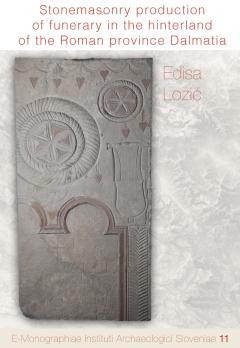Funerary Monuments in the Interior of the Roman Province of Dalmatia
Pričujoče delo se ukvarja z vprašanjem organizacije kamnoseške proizvodnje nagrobnih spomenikov na prostoru notranjega dela nekdanje rimske province Dalmacije. Cilj raziskave je bil prepoznati model kamnoseške proizvodnje, ki se je oblikoval na goratem in težko prehodnem območju, kjer so možnosti vodnega transporta kamnitega materiala minimalne. Avtorica izhajala iz predpostavke, da so se v času rimske oblasti na nekaterih geografskih območji oblikovala proizvodna središča, ki so za svoje delovanje uporabljala lokalne vira apnenca. Študija zajema nagrobne spomenike, odkrite na prostoru današnje Bosne in Hercegovine in zahodnega dela Srbije in Črne gore.
S kombinacijo metod makroskopske petrografske analize kamnin in tipološke analize ter prostorske analize je pokazala na obstoj več proizvodnih središč. Rezultati analiz kažejo na zelo verjetno možnost, da so izkoriščali lokalne vire apnenca. Epigrafski podatki pa so omogočili njihov obstoj tudi časovno opredeliti.
V osnovi je delo razdeljeno na dva dela. V prvem so predstavljeni rezultati analiz materiala, temu sledi tipološka analiza. Drugi del obsega katalog nagrobnih spomenikov.
V uvodu so predstavljena osnovna izhodišča raziskave in analize: najprej predstavitev in interpretacija rezultatov makroskopske petrografske analize materiala, ki je bila izvedena na nagrobnih spomenikih, shranjenih v Zemaljskem muzeju Sarajevo. Dobljene rezultate analiz materiala je bilo mogoče posplošiti na celoten korpus spomenikov. Ker gre za prostorsko razmeroma široko zastavljeno študijo, je ozemlje arbitrarno razdeljeno na več̌ delov, in sicer na severni, severozahodni, jugozahodni, južni, osrednji in vzhodni del Bosne in Hercegovine. V teh okvirjih so predstaviljeni rezultati analiz materiala z vsakega posameznega najdišča. Tipološka analiza predstavi tudi stele, pepelnice in pokrove, ki niso bili zajeti v analizo materiala. Tako se prostor raziskave nekoliko razširi proti vzhodu, kjer zajame manjši del spomenikov (nagrobne stele) iz jugozahodnega dela Srbije in severa Črne gore. Na tipološko analizo se navezuje poglavje Analiza prostorske razprostranjenosti posameznih tipov in podtipov, v katerem so na podlagi kartiranja posameznih tipov, podtipov in različic prostorsko definirana proizvodna središča. V poglavju Organizacija in proces proizvodnje se avtorica ukvarja z razumevanjem procesov proizvodnje nagrobnih spomenikov, ki so vodili od vira materiala (kamnoloma) do naročnika. V sklepu so navedene najpomembnejše ugotovitve raziskave.
Literaturi sledi še katalog spomenikov.
Prenosi

Licenca

To delo je licencirano pod Creative Commons Priznanje avtorstva-Nekomercialno-Deljenje pod enakimi pogoji 4.0 mednarodno licenco.
